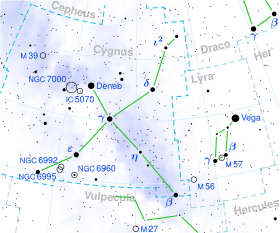35 Cygni
35 Cygni
Jump to navigation
Jump to search
 | |
| Observation data Epoch J2000 Equinox J2000 | |
|---|---|
Constellation | Cygnus |
Right ascension | 20h 18m 39.06986s[1] |
Declination | +34° 58′ 57.9909″[1] |
Apparent magnitude (V) | 5.18[2] |
| Characteristics | |
Spectral type | F6Ib[3] |
| B−V color index | +0.62[2] |
| Astrometry | |
| Radial velocity (Rv) | −20.20[4] km/s |
| Proper motion (μ) | RA: −0.05[1] mas/yr Dec.: −3.77[1] mas/yr |
| Parallax (π) | 1.03 ± 0.21[1] mas |
| Distance | approx. 3,200 ly (approx. 1,000 pc) |
| Absolute magnitude (MV) | −3.99[5] |
| Details | |
| Mass | 10.0[6] M☉ |
| Radius | 51[7] R☉ |
| Luminosity | 7,093[8] L☉ |
| Surface gravity (log g) | 1.5[6] - 2.4[5] cgs |
| Temperature | 6,360[5] K |
Metallicity [Fe/H] | 0.02[5] dex |
| Rotational velocity (v sin i) | 3.5[6] km/s |
| Age | 22[9] Myr |
| Other designations | |
35 Cyg, HR 7770, BD+34°3967, HD 193370, SAO 69806, FK5 3627, HIP 100122 | |
| Database references | |
| SIMBAD | data |
35 Cygni is a spectroscopic binary star in the constellation Cygnus. Its apparent magnitude is 5.18. Located around 1,000 parsecs (3,300 ly) distant, its primary is a yellow supergiant of spectral type F6Ib, a massive star that has used up its core hydrogen and is now fusing heavier elements.
Yellow supergiants are usually variable, often Classical Cepheid variables, but 35 Cyg is notable for having an especially constant brightness.[10]
35 Cyg is a single-lined spectroscopic binary with a period of 2,440 days (over 6 years).[11] The secondary cannot be seen directly, nor can its spectral lines be identified but the overall spectrum can be match by a combination of an F4 supergiant and a less luminous B6.5 star.[12]
References[edit]
^ abcde Van Leeuwen, F. (2007). "Validation of the new Hipparcos reduction". Astronomy and Astrophysics. 474 (2): 653. arXiv:0708.1752. Bibcode:2007A&A...474..653V. doi:10.1051/0004-6361:20078357..mw-parser-output cite.citation{font-style:inherit}.mw-parser-output q{quotes:"""""""'""'"}.mw-parser-output code.cs1-code{color:inherit;background:inherit;border:inherit;padding:inherit}.mw-parser-output .cs1-lock-free a{background:url("//upload.wikimedia.org/wikipedia/commons/thumb/6/65/Lock-green.svg/9px-Lock-green.svg.png")no-repeat;background-position:right .1em center}.mw-parser-output .cs1-lock-limited a,.mw-parser-output .cs1-lock-registration a{background:url("//upload.wikimedia.org/wikipedia/commons/thumb/d/d6/Lock-gray-alt-2.svg/9px-Lock-gray-alt-2.svg.png")no-repeat;background-position:right .1em center}.mw-parser-output .cs1-lock-subscription a{background:url("//upload.wikimedia.org/wikipedia/commons/thumb/a/aa/Lock-red-alt-2.svg/9px-Lock-red-alt-2.svg.png")no-repeat;background-position:right .1em center}.mw-parser-output .cs1-subscription,.mw-parser-output .cs1-registration{color:#555}.mw-parser-output .cs1-subscription span,.mw-parser-output .cs1-registration span{border-bottom:1px dotted;cursor:help}.mw-parser-output .cs1-hidden-error{display:none;font-size:100%}.mw-parser-output .cs1-visible-error{font-size:100%}.mw-parser-output .cs1-subscription,.mw-parser-output .cs1-registration,.mw-parser-output .cs1-format{font-size:95%}.mw-parser-output .cs1-kern-left,.mw-parser-output .cs1-kern-wl-left{padding-left:0.2em}.mw-parser-output .cs1-kern-right,.mw-parser-output .cs1-kern-wl-right{padding-right:0.2em}
^ ab Luck, R. Earle (2014). "Parameters and Abundances in Luminous Stars". The Astronomical Journal. 147 (6): 137. Bibcode:2014AJ....147..137L. doi:10.1088/0004-6256/147/6/137.
^ Abt, Helmut A. (2009). "MK Classifications of Spectroscopic Binaries". The Astrophysical Journal Supplement. 180: 117. Bibcode:2009ApJS..180..117A. doi:10.1088/0067-0049/180/1/117.
^ Gontcharov, G. A. (2006). "Pulkovo Compilation of Radial Velocities for 35 495 Hipparcos stars in a common system". Astronomy Letters. 32 (11): 759. arXiv:1606.08053. Bibcode:2006AstL...32..759G. doi:10.1134/S1063773706110065.
^ abcd Kovtyukh, V. V.; Gorlova, N. I.; Belik, S. I. (2012). "Accurate luminosities from the oxygen λ7771-4 Å triplet and the fundamental parameters of F-G supergiants". Monthly Notices of the Royal Astronomical Society. 423 (4): 3268. arXiv:1204.4115. Bibcode:2012MNRAS.423.3268K. doi:10.1111/j.1365-2966.2012.21117.x.
^ abc Lyubimkov, Leonid S.; Lambert, David L.; Kaminsky, Bogdan M.; Pavlenko, Yakov V.; Poklad, Dmitry B.; Rachkovskaya, Tamara M. (2012). "Lithium abundance in atmospheres of F- and G-type supergiants and bright giants". Monthly Notices of the Royal Astronomical Society. 427: 11. arXiv:1212.6057. Bibcode:2012MNRAS.427...11L. doi:10.1111/j.1365-2966.2012.21617.x.
^ Pasinetti Fracassini, L. E.; Pastori, L.; Covino, S.; Pozzi, A. (2001). "Catalogue of Apparent Diameters and Absolute Radii of Stars (CADARS) - Third edition - Comments and statistics". Astronomy and Astrophysics. 367 (2): 521. arXiv:astro-ph/0012289. Bibcode:2001A&A...367..521P. doi:10.1051/0004-6361:20000451.
^ McDonald, I.; Zijlstra, A. A.; Boyer, M. L. (2012). "Fundamental parameters and infrared excesses of Hipparcos stars". Monthly Notices of the Royal Astronomical Society. 427: 343. arXiv:1208.2037. Bibcode:2012MNRAS.427..343M. doi:10.1111/j.1365-2966.2012.21873.x.
^ Lyubimkov, Leonid S.; Lambert, David L.; Rostopchin, Sergey I.; Rachkovskaya, Tamara M.; Poklad, Dmitry B. (2010). "Accurate fundamental parameters for A-, F- and G-type Supergiants in the solar neighbourhood". Monthly Notices of the Royal Astronomical Society. 402 (2): 1369. arXiv:0911.1335. Bibcode:2010MNRAS.402.1369L. doi:10.1111/j.1365-2966.2009.15979.x.
^ Adelman, S. J.; Cay, I. H.; Cay, M. T.; Kocer, D. (2000). "On the Variability of A6 to F9 Supergiants". Information Bulletin on Variable Stars. 4947: 1. Bibcode:2000IBVS.4947....1A.
^ Pourbaix, D.; Tokovinin, A. A.; Batten, A. H.; Fekel, F. C.; Hartkopf, W. I.; Levato, H.; Morrell, N. I.; Torres, G.; Udry, S. (2004). "SB9: The ninth catalogue of spectroscopic binary orbits". Astronomy and Astrophysics. 424 (2): 727. arXiv:astro-ph/0406573. Bibcode:2004A&A...424..727P. doi:10.1051/0004-6361:20041213.
^ Parsons, Sidney B.; Ake, Thomas B. (1998). "Ultraviolet and Optical Studies of Binaries with Luminous Cool Primaries and Hot Companions. V. The Entire IUE Sample". The Astrophysical Journal Supplement Series. 119: 83. Bibcode:1998ApJS..119...83P. doi:10.1086/313152.
Categories:
- Cygnus (constellation)
- Flamsteed objects
- F-type supergiants
- Spectroscopic binaries
- B-type main-sequence stars
- HR objects
- Henry Draper Catalogue objects
- Durchmusterung objects
- Hipparcos objects
(window.RLQ=window.RLQ||).push(function(){mw.config.set({"wgPageParseReport":{"limitreport":{"cputime":"0.600","walltime":"0.685","ppvisitednodes":{"value":1881,"limit":1000000},"ppgeneratednodes":{"value":0,"limit":1500000},"postexpandincludesize":{"value":136470,"limit":2097152},"templateargumentsize":{"value":4500,"limit":2097152},"expansiondepth":{"value":14,"limit":40},"expensivefunctioncount":{"value":3,"limit":500},"unstrip-depth":{"value":1,"limit":20},"unstrip-size":{"value":38856,"limit":5000000},"entityaccesscount":{"value":3,"limit":400},"timingprofile":["100.00% 416.779 1 -total"," 50.60% 210.894 1 Template:Reflist"," 43.77% 182.422 12 Template:Cite_journal"," 17.03% 70.990 5 Template:Navbox"," 12.70% 52.947 1 Template:Starbox_image"," 12.44% 51.827 1 Template:Stars_of_Cygnus"," 11.26% 46.922 1 Template:Location_mark"," 10.72% 44.665 1 Template:Location_mark+"," 7.99% 33.309 11 Template:Ifempty"," 6.47% 26.977 1 Template:Convert"]},"scribunto":{"limitreport-timeusage":{"value":"0.225","limit":"10.000"},"limitreport-memusage":{"value":7033641,"limit":52428800}},"cachereport":{"origin":"mw1255","timestamp":"20181018204715","ttl":1900800,"transientcontent":false}}});mw.config.set({"wgBackendResponseTime":813,"wgHostname":"mw1255"});});